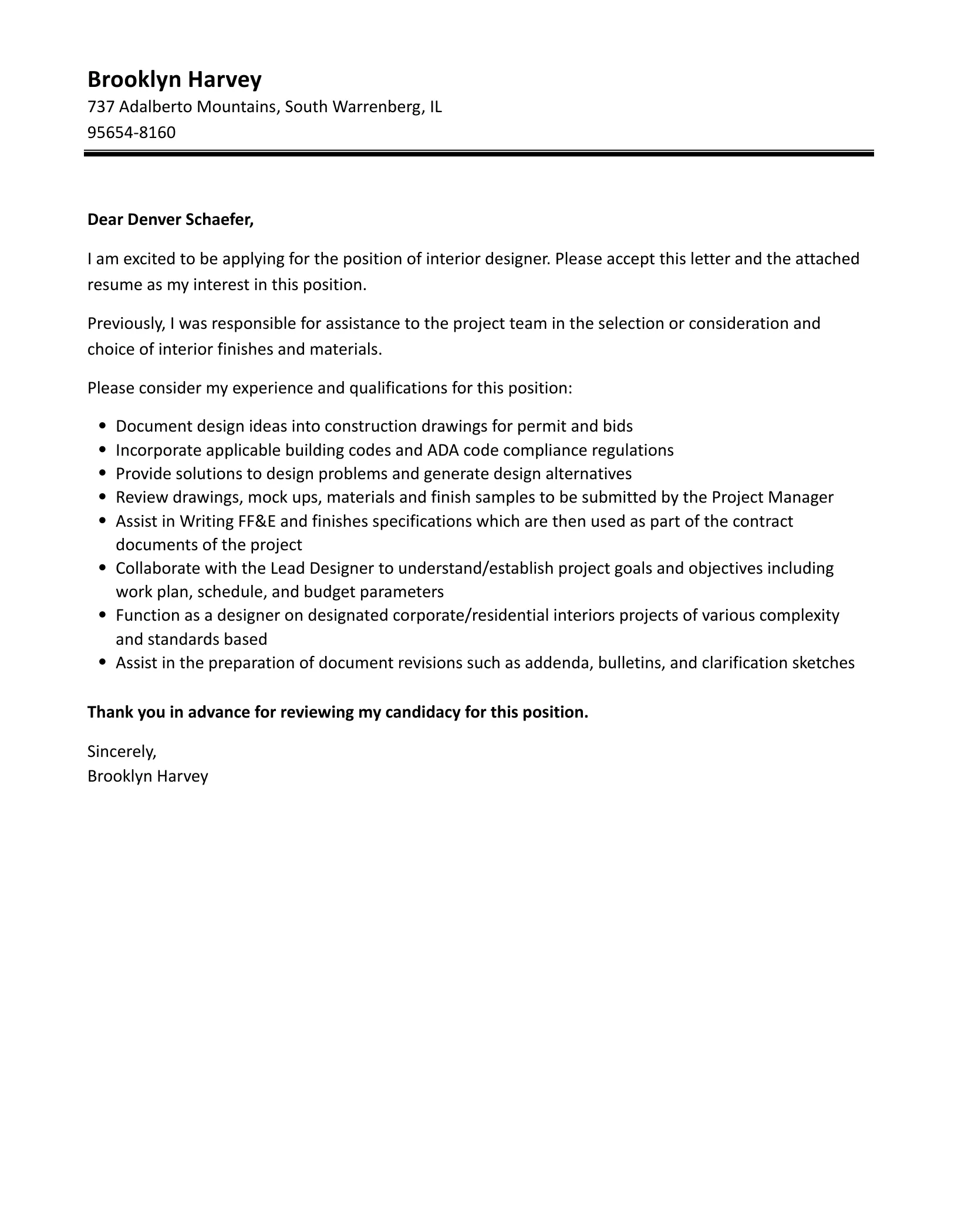The Power of a Strong Interior Design Cover Letter
A well-crafted interior design job cover letter is your first opportunity to make a positive impression on a potential employer. It’s your chance to go beyond the bullet points of your resume and showcase your personality, passion for design, and relevant skills. In the competitive field of interior design, where creativity and communication are paramount, a compelling cover letter can be the key to unlocking your dream job. The cover letter is not just a formality; it’s a strategic tool to present yourself as the ideal candidate and set yourself apart from the competition. It should be tailored to each specific job and highlight how your unique abilities align with the needs of the company and the specific role.
Understanding the Purpose of a Cover Letter
The primary purpose of a cover letter is to introduce yourself and express your interest in a particular interior design position. It provides context to your resume, explaining why you are a suitable candidate. It allows you to demonstrate your understanding of the company’s values, projects, and design philosophy. Unlike a resume, a cover letter permits you to express your enthusiasm for the role, elaborate on your design approach, and connect with the hiring manager on a more personal level. It serves as a bridge between your qualifications and the company’s needs, making it clear how you can contribute to their success. It also gives you the opportunity to address any potential concerns or gaps in your resume while reinforcing your strengths.
Highlighting Your Skills and Experience
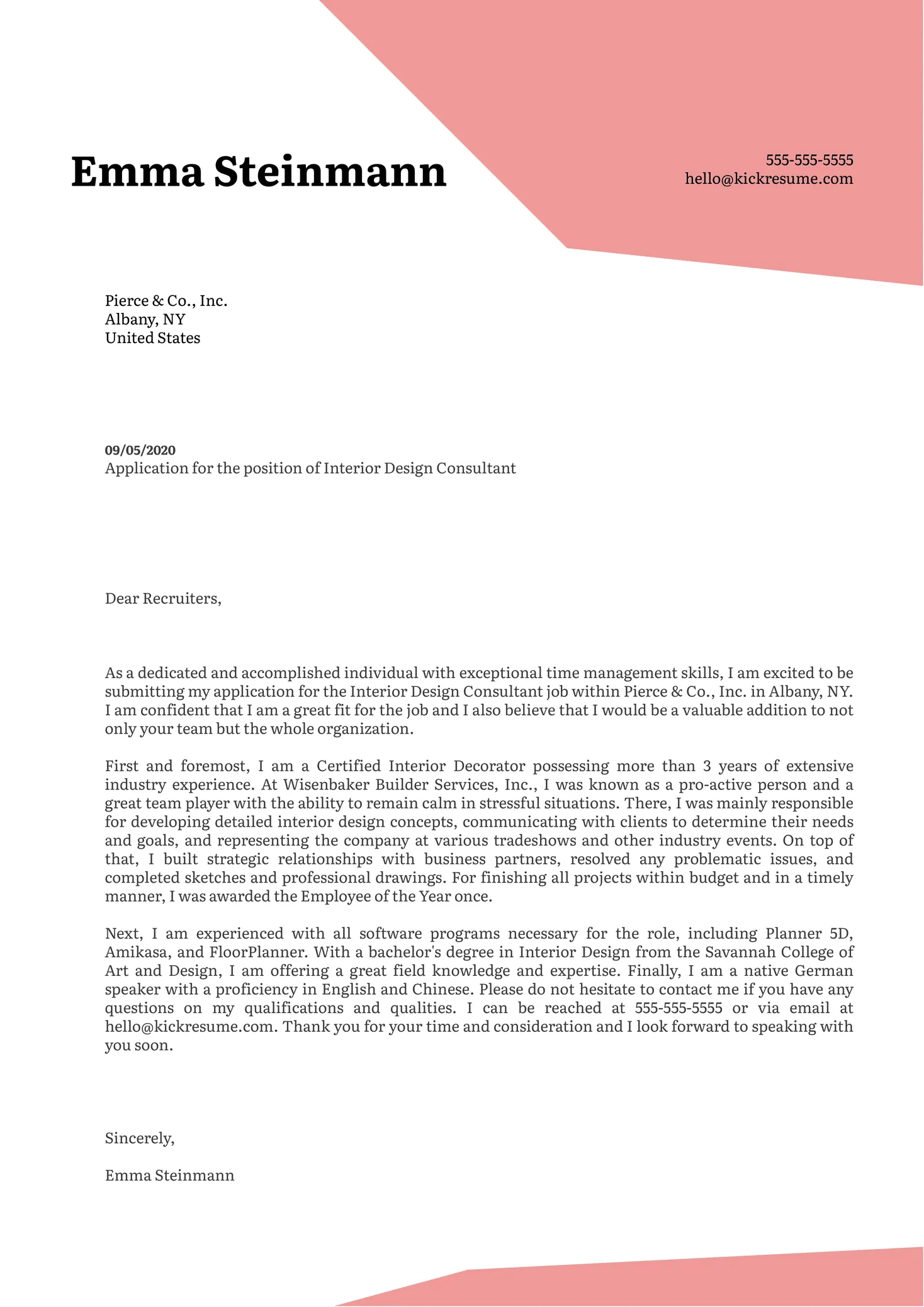
Your cover letter should prominently feature your relevant skills and experience. This includes technical skills like proficiency in design software (AutoCAD, Revit, SketchUp, etc.) and knowledge of building codes, as well as soft skills such as communication, project management, and problem-solving. Focus on achievements rather than just listing responsibilities. For example, instead of saying “Managed client projects”, you could write “Successfully managed and delivered over 10 client projects, resulting in a 95% client satisfaction rate.” Use action verbs to describe your accomplishments and provide specific examples to illustrate your capabilities. This helps the hiring manager to quickly understand the value you bring to the table. Make sure your skills and experience align with the requirements listed in the job description.
Essential Components of an Interior Design Cover Letter
Header and Contact Information
Start your cover letter with a professional header. Include your full name, address, phone number, and email address. If you have a website or online portfolio, include the link as well. Make sure the header is clean and easy to read. The contact information should match the information on your resume. This ensures the hiring manager can easily contact you. Consider using a professional-looking template to ensure a polished presentation. Proper formatting in the header sets a positive tone from the start and showcases your attention to detail, which is crucial in interior design.
The Salutation Addressing the Hiring Manager
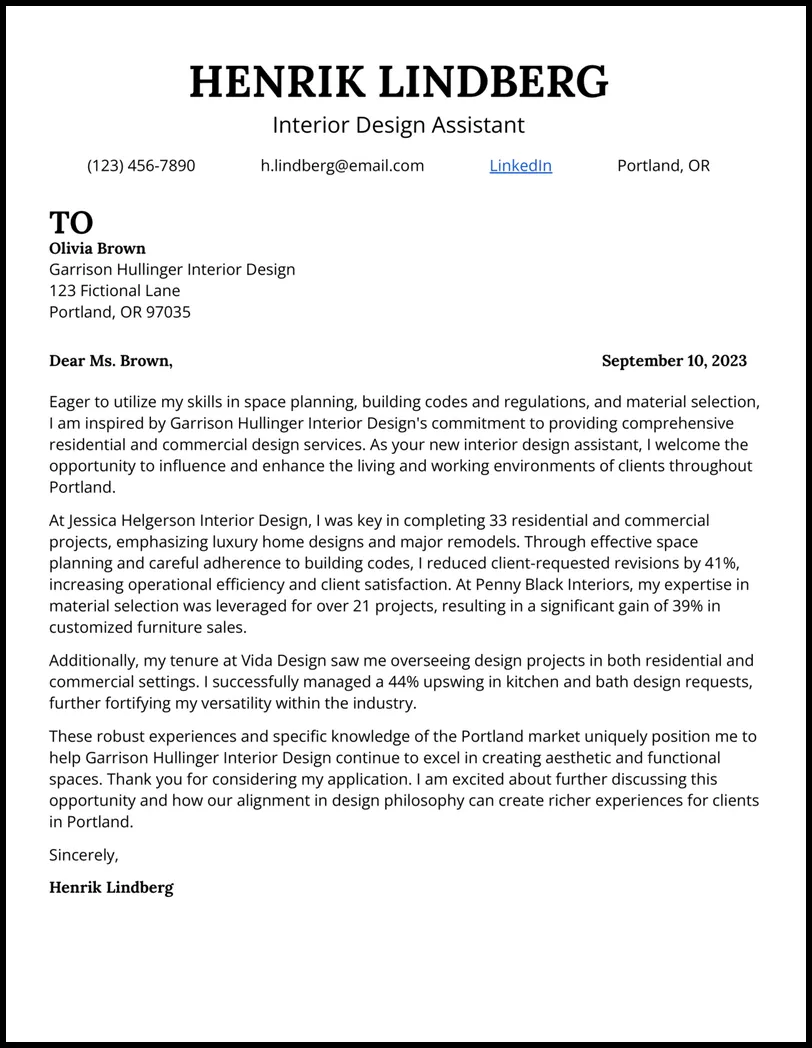
Always address your cover letter to a specific person if possible. Research the company website or LinkedIn to find the name of the hiring manager or the person in charge of hiring. If you can’t find a specific name, use a professional greeting like “Dear Hiring Manager.” Avoid generic salutations like “To Whom It May Concern.” Personalizing the salutation demonstrates that you have taken the time to research the company and shows respect for the recipient. Proper salutation immediately grabs the attention of the hiring manager and shows you’ve done your homework and are truly interested in the role.
Crafting a Compelling Opening Paragraph
The opening paragraph is your hook. It should immediately grab the reader’s attention and make them want to read more. Clearly state the position you are applying for and where you found the job posting. Then, briefly explain why you are interested in the role and the company. You might also include a brief, compelling statement about your passion for interior design or a relevant achievement. The goal is to immediately show your enthusiasm and make the hiring manager intrigued by your qualifications. Make sure this opening is personalized and shows a genuine interest in the company, rather than a generic statement. This opening statement sets the tone and establishes your enthusiasm from the get-go.
Body Paragraphs Showcasing Your Abilities
The body paragraphs are where you showcase your skills and experience in detail. Use these paragraphs to provide specific examples of your accomplishments and how they relate to the job requirements. Highlight your relevant skills and experiences, such as your expertise in space planning, material selection, or project management. The most effective cover letters provide tangible evidence of your abilities rather than just a list of skills. Focus on what you have done, what results you achieved, and how you can bring value to the company. Structure your paragraphs logically, using clear and concise language. Each paragraph should address a specific point or accomplishment, making sure to align with the requirements outlined in the job description.
Quantifying Your Achievements
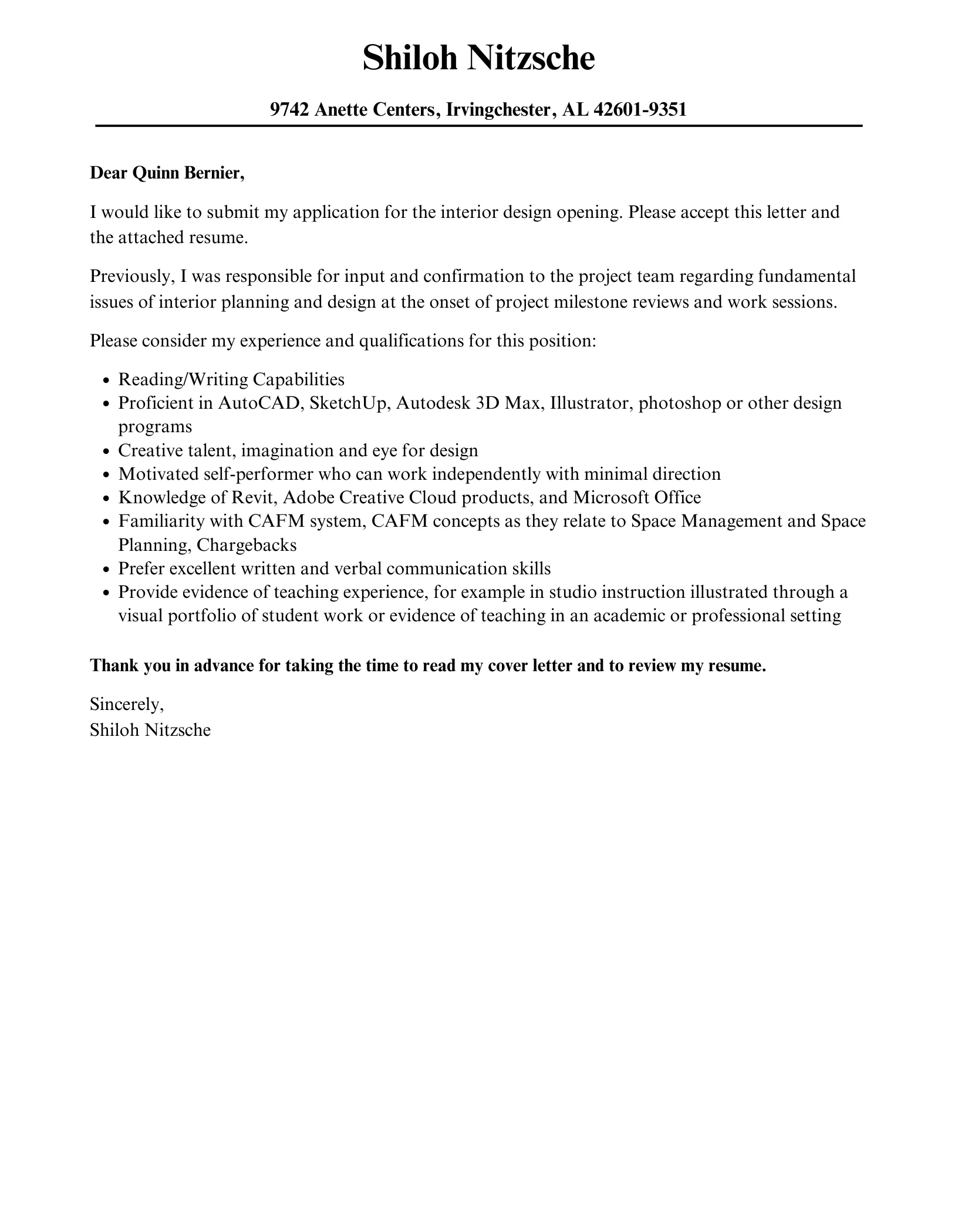
Whenever possible, quantify your achievements. Use numbers and data to demonstrate the impact of your work. For example, instead of saying “Improved project efficiency,” say “Improved project efficiency by 15% by implementing a new project management system.” Similarly, instead of stating “Managed multiple projects,” say “Managed 5+ concurrent projects with budgets ranging from $50,000 to $250,000.” Quantifying your achievements provides concrete evidence of your abilities and makes your claims more persuasive. This is particularly useful in demonstrating your impact, making it easy for the hiring manager to measure your value. Use quantifiable results to highlight your contributions to past projects.
Tailoring Your Letter to the Job Description
Always tailor your cover letter to the specific job description. Carefully read the job posting and identify the key requirements and skills the employer is seeking. Then, customize your cover letter to address these specific needs. Highlight your relevant skills and experience and provide examples of how you have successfully used them in past projects. Avoid using a generic cover letter. Tailoring your letter shows that you have taken the time to understand the job requirements and that you are genuinely interested in the position. It also increases your chances of making a positive impression and getting noticed by the hiring manager. This also makes the hiring manager feel you are the ideal candidate for the role.
The Closing Paragraph and Call to Action
The closing paragraph should reiterate your interest in the position and thank the hiring manager for their time and consideration. Reiterate your enthusiasm for the opportunity and briefly summarize your key qualifications. Include a clear call to action, such as stating that you are available for an interview and providing your contact information again. End with a professional closing like “Sincerely” or “Best regards,” followed by your name. Make sure the tone is positive, confident, and professional. It should summarize your key qualifications, and reemphasize your interest. This final paragraph should leave a lasting positive impression.
Formatting and Design Tips
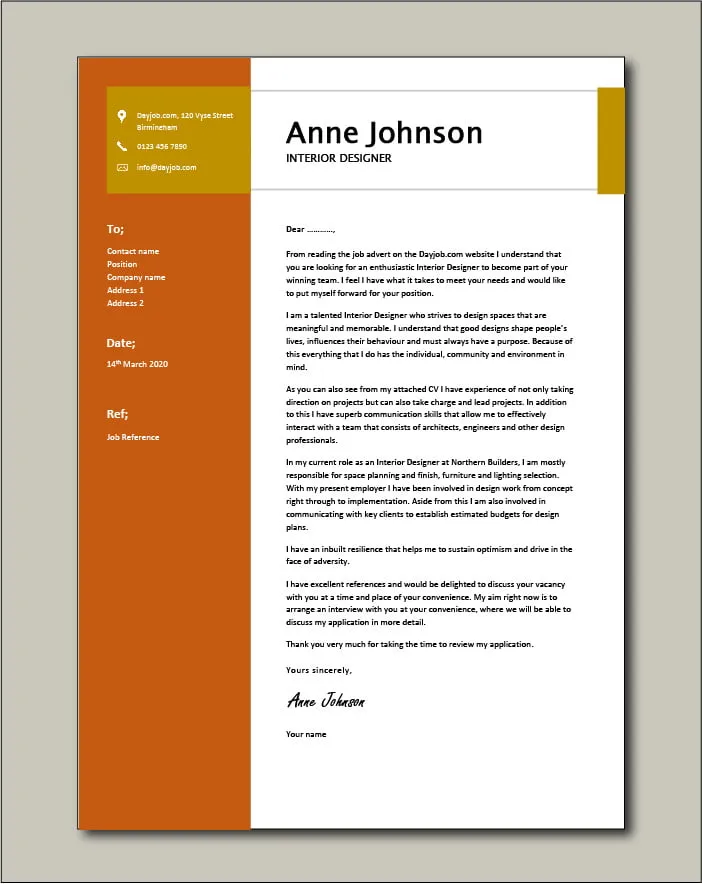
Choosing the Right Font and Layout
The formatting and design of your cover letter are just as important as the content. Use a professional-looking font such as Arial, Calibri, or Times New Roman. Ensure the font size is between 10 and 12 points to ensure readability. Maintain consistent formatting throughout the document. Use clear headings and bullet points to break up text and make it easier to read. The layout should be clean, with ample white space. Avoid using excessive colors or graphics, unless they are part of your personal brand. Your cover letter should be visually appealing and easy for the hiring manager to scan. A well-formatted letter shows attention to detail and professionalism, which are highly valued in interior design.
Proofreading and Editing for Perfection
Proofreading and editing are essential steps in ensuring your cover letter is free of errors. Carefully review your cover letter for any grammatical errors, spelling mistakes, and typos. Read your cover letter aloud to catch any awkward phrasing or sentence structure. It’s also a good idea to have someone else proofread your cover letter. A fresh pair of eyes can often spot errors that you might have missed. Make sure the tone is consistent throughout the document. A polished cover letter demonstrates attention to detail and professionalism. Proofreading ensures that your message is clear, concise, and error-free. Proofreading validates that you have excellent attention to detail.
Avoiding Common Mistakes in Interior Design Cover Letters
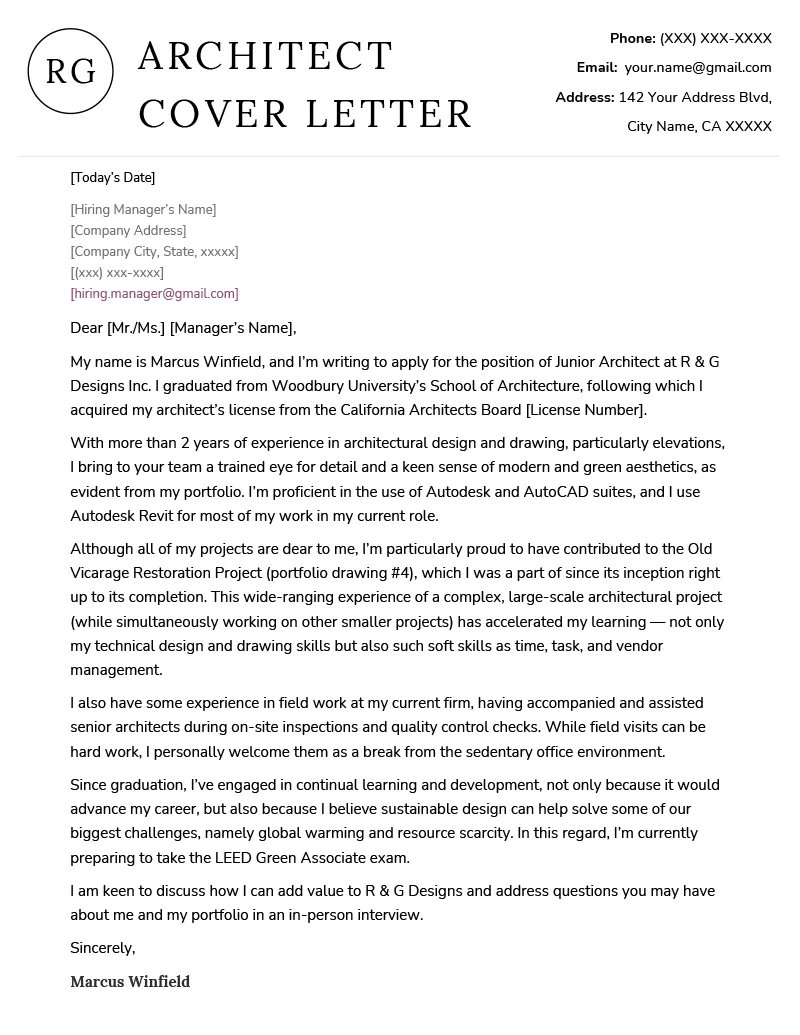
Generic vs. Personalized Letters
One of the biggest mistakes is sending a generic cover letter that is not tailored to the specific job or company. Always customize your cover letter to match the job description and highlight the skills and experiences most relevant to the position. Research the company and its projects and tailor your letter to reflect your understanding of their design philosophy and values. Generic cover letters are easily identifiable and show a lack of interest. Personalizing the letter allows you to stand out from other applicants. It shows you’ve invested time and effort.
Overusing Industry Jargon
Avoid using excessive industry jargon or technical terms that the hiring manager may not understand. While it’s important to demonstrate your knowledge of the field, using too much jargon can make your cover letter difficult to read and understand. Instead, use clear, concise language that is easy to understand. Focus on conveying your ideas effectively and clearly. Avoid using jargon that might confuse the hiring manager. Use language that is understood by all. Simplicity in your approach is always the best option.
Focusing Too Much on Yourself
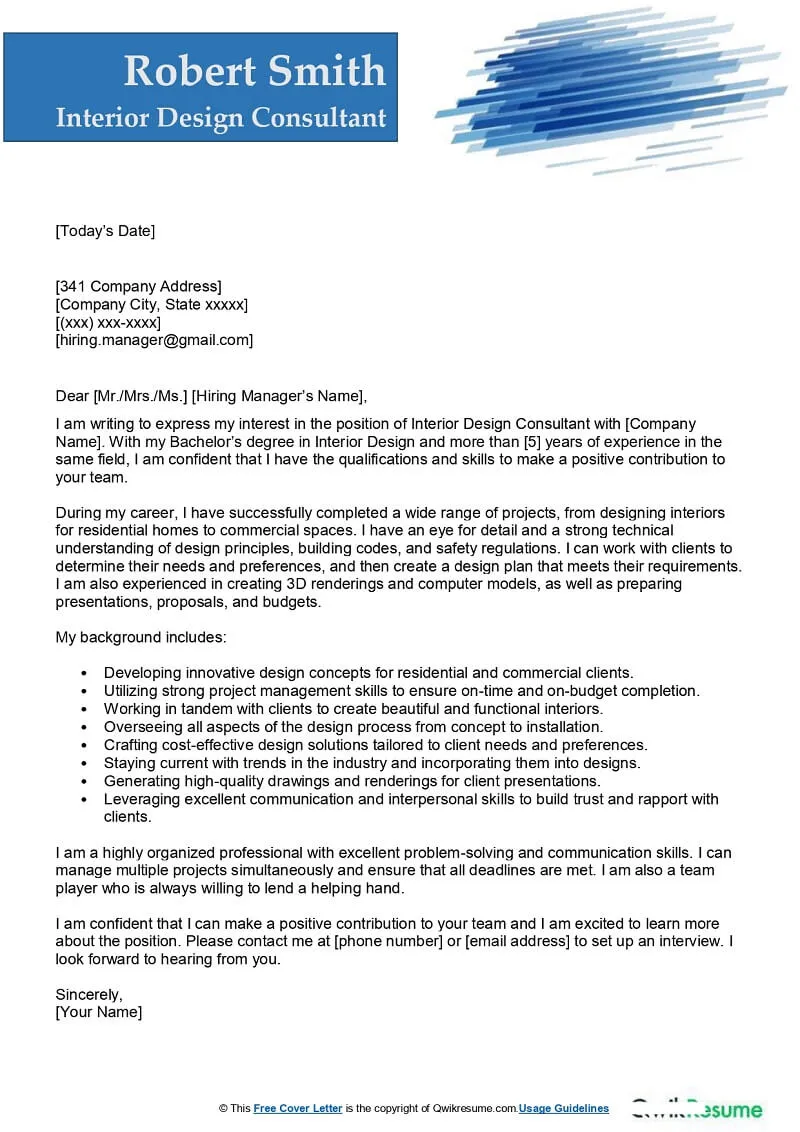
While it’s important to highlight your skills and experience, avoid focusing too much on yourself. Your cover letter should not be a long list of your accomplishments. Instead, focus on how your skills and experiences can benefit the company. Explain how you can contribute to their success and solve their design challenges. Show the hiring manager that you understand their needs. Emphasize the value you can bring to the team. Focus on how you can help the company achieve its goals.
Tips for Different Experience Levels
Entry-Level Cover Letter Strategies
If you are an entry-level applicant, emphasize your education, internships, and any relevant coursework or projects. Highlight any design software skills or technical skills you have acquired. Showcase your passion for interior design and your eagerness to learn and grow. If you lack direct work experience, focus on transferable skills, such as communication, problem-solving, and teamwork, which are applicable across many roles. Consider including a portfolio of your design work, even if it’s from school projects, to showcase your creativity and design abilities. Demonstrate enthusiasm and a willingness to learn.
Experienced Designers Cover Letter Advice
Experienced designers should highlight their most relevant and impressive projects and accomplishments. Quantify your achievements whenever possible. Focus on the results you have achieved in past roles, such as increased sales, reduced costs, or improved client satisfaction. Demonstrate your leadership skills and any experience managing projects or teams. Tailor your cover letter to demonstrate how your experience and expertise align with the specific requirements of the job and the company’s design philosophy. Provide details on your most successful projects and highlight your expertise in the field.
Cover Letters for Career Changers
If you are changing careers, highlight transferable skills and experiences from your previous roles. Explain why you are interested in interior design and how your previous experience can be applied. Emphasize any relevant skills, such as project management, client communication, or creative problem-solving. Focus on the aspects of your background that align with the requirements of the job and demonstrate your ability to adapt. Consider including a portfolio of any design-related work or personal projects to showcase your interest and abilities. Make a compelling case that you’re a good fit for the role.
Showcasing Your Portfolio
Mentioning Your Portfolio Effectively
Your portfolio is a critical part of your application. Mention your portfolio in your cover letter and encourage the hiring manager to view it. Briefly describe the contents of your portfolio, highlighting the projects that are most relevant to the job. Explain how your portfolio showcases your design style, skills, and experience. This introduction will increase the chances that the hiring manager will actually look at your portfolio. Highlighting some specific projects will give them a quick preview of what they can expect to see. Mentioning your portfolio is a great way to reinforce your qualifications.
Providing a Link or Attachment
Make it easy for the hiring manager to view your portfolio by providing a direct link or attaching it to your email. If you have an online portfolio, include the link in your header and in the body of your cover letter. If you have a PDF portfolio, attach it to your email. Ensure that your portfolio is well-organized, easy to navigate, and showcases your best work. Make sure the link is working correctly before submitting your application. Make sure the attachment is small enough to send through email, but large enough to show your work. Make it accessible and professional.
Finalizing and Submitting Your Cover Letter
Before submitting your cover letter, carefully review it one last time to ensure it is free of errors. Double-check that all contact information is correct and that you have addressed the cover letter to the correct person. Make sure your cover letter is formatted correctly and is easy to read. Save your cover letter as a PDF file to preserve the formatting. Send your cover letter and resume together as attachments. Follow the instructions provided in the job posting for submitting your application. A polished, error-free cover letter shows that you’re serious about the role, giving you the best chance of getting hired. Finally, always follow up after submitting your application.
